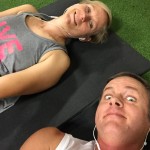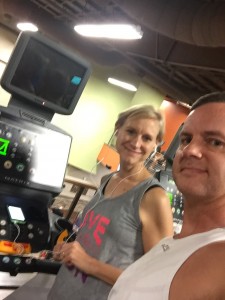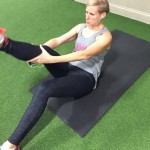What to Do When You Can’t Run
Most of us have been there and, as we write this article, Mary Catherine isn’t able to run due to a hamstring injury. Joe has had to cut back on speed workouts and mileage due to knee problems. Yes, these are among the joys of being a middle-aged runner. The fact that you’re reading this article means you or a friend might be dealing with a similar situation. So what can you do? In short, do what you can do. As it turns out, there’s lots of things you can do when you can’t run.
Before sharing some ideas about what you can do when you can’t run, we’d like to clarify a few things. First, let’s make a distinction between “can’t run” and “won’t run” or “don’t want to run”. We’re assuming that you actually want to run, but can’t. Lack of motivation to run is a different issue (we’ve been there too) which we’ll cover in a future blog post. Next, we assume that you will be able to return to “normal” running at some future point and that you’re not permanently disabled in some way (although the tips in this article might apply if that’s the case, too). Finally, we’re going to adopt the point of view that you can’t run due to injury (although the tips here might apply if your inability to run is due to weather or some other issue). Okay, got it – so what can you do when you can’t run?
Have a Positive Attitude
The most important tip is don’t despair! For many runners (including us) the biggest source of anguish is attitudinal. Running is much more than physical exercise for us. When we can’t run, we get grumpy, tired, sluggish, and depressed. Having a negative attitude sets up a downward spiral that actually inhibits physical recovery. Mind and body are related, so keep that positive attitude to speed up recovery and your return to running. What are some ways to stay positive?
- Get inspired! Read an inspirational comeback story or watch one of your favorite running movies.
- Do something else – a list is provided below in the next section. Now’s your chance to try something new.
- Talk about it with running friends. They may have dealt with a similar situation and you can learn from them.
- Focus on the positive in your life right now, which might not be running at this particular moment in time.
- Avoid the negative – feeling sorry for yourself? Take a deep breath, acknowledge the negative and move on. Don’t dwell upon it.
Do Something Else
Finding alternatives to running will really depend on the nature and extent of your running injuries or impediments. In general, plan on working on your overall fitness (not just running) in the areas of cardiovascular conditioning, strength, and flexibility. Your unplanned recovery period is a chance to try some new things that you wouldn’t otherwise consider. Again, your list of alternatives will differ based on your injury or impediment. It goes with saying, but we’ll say it anyway – don’t hurt yourself. If you shouldn’t run – don’t. If you’re not supposed to put a lot of weight on your legs – don’t. Be smart! Here’s some things that we we’ve tried over the years when we couldn’t run:
- Walking – if we can’t run, but we can walk – that’s our favorite running alternative. Walk around the block, in a park, or wherever you can. Put on a backpack and hike a mountain, that’ll build leg strength and get your heart pumping.
- Treadmill / Elliptical trainer – Mary Catherine prefers the treadmill and Joe prefers the elliptical. Both are great exercises that are similar to running and get in a solid workout.
- Cycling – outdoor or indoor cycling, a great non-impact way to get in a quality cardiovascular workout.
- Rowing – whether it’s on a machine at the gym or outdoors, this will provide a total body workout that’ll keep your conditioning level very high.
- Fitness classes – dance, step, kettle bells, tabata, kickboxing, or group barbell training – there’s a lot of different ways to exercise at your local gym, YMCA, or recreation center. (As an aside, Joe has promised Mary Catherine to try ballroom dancing someday).
- Pool exercises – we’ve never gotten the hang of pool running (although we know some folks who have). Also, consider lap swimming or water aerobics for a great, non-impact total body workout.
- Resistance training – we prefer free weights, but resistance bands or machines can help you maintain strength too. Cut the rest between sets and do compound movements for a good cardiovascular workout. A set of power cleans or lunges will wake-up your body!
- Bootcamp training – Joe has fond memories of doing calisthenics in the Army. People pay money to do it now. Drop and do some push-ups, mountain climbers, or burpees. Jump up to a pull-up bar and knock ’em out.
- Yoga / Pilates – maintaining flexibility is important, even more important if you’re not training as much as you were. It’s easy to settle back into routines where you do a lot of sitting around. Stretch your limbs and keep that core strong.
- Rock climbing – have you ever tried it? Strength, flexibility, cardiovascular conditioning, and balance – you’ll find it all while climbing a wall.
- Other sports – golf, tennis, bowling, skating – there’s no shortage of recreational opportunities in this country. Try a new sport during your recovery.
- What ideas do you have? Feel free to share some ideas of your own in the comments section down below.
Ease Back Into Running
Most runners lose conditioning when they can’t run. There’s really not a way to candy-coat that. In order to be an efficient runner, you need to run. While some of the alternatives listed above may help maintain overall fitness, you will need to adopt a mindset of gradual recovery when you return to running – keyword being “gradual”. Let your body’s feedback and any professional medical counsel you’ve received help you determine how gradual your recovery should be. Some people bounce right back and others take awhile. Each step forward is progress. Increase your volume (the amount of miles or time you run) first to re-establish your base. Once you’re ready, then you can add back in the speed workouts – intervals and tempo runs. I’m not sure why it’s the case (perhaps the rest & recovery), but I almost always come back stronger and faster after an unplanned break from running.
Be Grateful for Running
Like a lot of things in life, it’s easy to forget how much you miss something until it’s not there anymore – this would include running. Once you’re back on the road, trail, or treadmill be grateful for our sport and your ability to participate in it. Reflect back on your path to recovery and share some positivity with another runner who may not be able to run right now. There’s a bright road ahead for us all.
Wanna share? Tell us ways you stay motivated and in shape when you can’t run. Share your comments below. Thanks.











